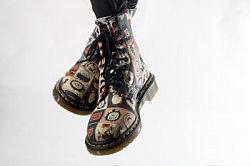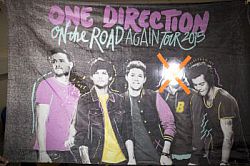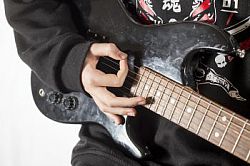Children preserve everyday objects in digital archive
Toy animals, a pair of Dr Martens boots and a defaced picture of the One Direction boy band are all part of a new interactive digital archive created at Sussex.
 Children made a digital archive of the objects that were important to them at a recent event on the Sussex campus.
Children made a digital archive of the objects that were important to them at a recent event on the Sussex campus.
 One of the objects was a flag showing the One Direction boy band, with sticky tape over the face of a band member who left the group.
One of the objects was a flag showing the One Direction boy band, with sticky tape over the face of a band member who left the group.
 This second-hand guitar was also chosen to enter the 'Everyday Childhoods' archive.
This second-hand guitar was also chosen to enter the 'Everyday Childhoods' archive.
The objects were among those selected by 12 to 16‑year‑old Brighton and Hove school children for preservation in the ‘Everyday Childhoods’ archive, part of a collection documenting everyday life in Britain.
The children experimented with photography, film, video games and other digital media to celebrate the objects that were important to them at a workshop at the University on Saturday (14 November).
Researchers at the University’s Sussex Humanities Lab partnered with the Mass Observation Archive to organise the workshop, which builds on previous research at Sussex into how children’s lives are documented.
With help from the researchers, the young people used computer code and apps to create video games and animations that told the stories behind their everyday objects, which also included a games console, a Terry Pratchett novel and a Wyndham Lewis novel.
Dr Liam Berriman, Lecturer in Digital Humanities and workshop organiser, explained: “Children's everyday lives are heavily underrepresented in archives. One of our big overall aims has been to start to rectify this, and ensure that their voices are included as important historical record for the future.
“We want children to play a role in deciding how their lives are represented and their stories are told.”
The children from Hove Park, BHASVIC and other local schools enjoyed the event, with one commenting, “it made me think more about personal connections to everyday objects,” and another adding, “I enjoyed playing around with all the super tech.”
The Mass Observation team intends to make the collection – including photographs of the objects, audio recordings of interviews with the children, and other materials from the workshop – available to the general public in the coming months.
Suzanne Rose, Education & Outreach Officer at the Mass Observation Archive, said: “The archive is not just about preserving material that’s been collected, but also about capturing the now.
“It’s really important to be working with young people today, so that children in future can look back and see what was important to their age group in 2015.”
The workshop was organised and funded as part of the ESRC Festival of Social Science 2015. It also received funding support from the Digital Economy ‘Communities and Cultures’ Network+, and the University of Sussex’s Centre for Innovation and Research in Childhood at Youth.
